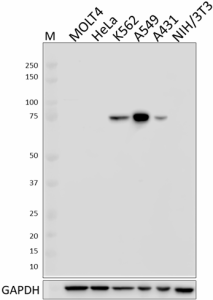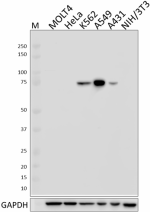- Clone
- W17122A (See other available formats)
- Regulatory Status
- RUO
- Other Names
- C Polypeptide, Protein-Glutamine-Gamma-Glutamyltransferase, Protein-Glutamine Gamma-Glutamyltransferase 2, Transglutaminase C, Transglutaminase H, Tissue Transglutaminase, Transglutaminase 2
- Isotype
- Rat IgG2a, κ
- Ave. Rating
- Submit a Review
- Product Citations
- publications

-

Total cell lysates (15 µg total protein) from MOLT-4 and HeLa cells (negative control), K562, A549, A431 and NIH/3T3 cells were resolved by 4-12% Bis-Tris gel electrophoresis, transferred to a PVDF membrane, and probed with 1.0 µg/mL (1:500 dilution) of Purified anti-TGM2 Antibody, clone W17122A, overnight at 4°C. Proteins were visualized by chemiluminescence detection using HRP Goat anti-rat IgG antibody (Cat. No. 405405) at a 1:3000 dilution. Direct-Blot™ HRP anti-GAPDH Antibody (Cat. No. 607904) was used as a loading control at a 1:10000 dilution (lower). Lane M: Molecular Weight marker. Predicted TGM2 expression data was obtained from Human Protein Atlas. -

IHC staining of purified anti-TGM2 (clone W17122A) on formalin-fixed paraffin-embedded human placenta tissue. Following antigen retrieval using Tris-EDTA (10 mM Tris, 1 mM EDTA, 0.05% Tween-20, pH 9.0), the tissue was incubated without (panel A) and with (panel B) 1.0 µg/mL of purified anti-TGM2 (clone W17122A) overnight at 4°C, followed by incubation with 2.5 µg/mL of Alexa Fluor® 647 goat anti-mouse IgG (Cat. No. 405322) for 1 hour at room temperature. Nuclei were counterstained with DAPI (Cat. No. 422801). Images were captured with a 40X objective. Scale bar: 50 µm
| Cat # | Size | Price | Save |
|---|---|---|---|
| 616601 | 25 µg | ¥22,220 | |
| 616602 | 100 µg | ¥55,660 |
Transglutaminase 2 (TGM2) is a multifunctional enzyme required for diverse cellular processes, including cell death, differentiaton, apoptosis, and cell migration. TGM2 catalyzes the crosslinking through calcium-activated transamidation of available glutamine and lysine residues on substrate proteins. TGM2 also has GTPase and ATPase activity; transamidation activity is allosterically inhibited by guanine nucleotide binding. It is essential for cancer stem cell survival and is a chemotherapy resistance factor.
Product DetailsProduct Details
- Verified Reactivity
- Human
- Antibody Type
- Monoclonal
- Host Species
- Rat
- Immunogen
- Partial human recombinant human TGM2 protein corresponding to amino acids 1-250.
- Formulation
- Phosphate-buffered solution, pH 7.2, containing 0.09% sodium azide.
- Preparation
- The antibody was purified by affinity chromatography.
- Concentration
- 0.5 mg/mL
- Storage & Handling
- The antibody solution should be stored undiluted between 2°C and 8°C.
- Application
-
WB - Quality tested
IHC-P - Verified - Recommended Usage
-
Each lot of this antibody is quality control tested by Western blotting. For Western blotting, the suggested use of this reagent is 0.1 - 1.0 µg per mL. For immunohistochemistry on formalin-fixed paraffin-embedded tissue sections, a concentration range of 1 - 10 µg/mL is suggested. It is recommended that the reagent be titrated for optimal performance for each application.
- Application Notes
-
This clone was tested for ICC using PFA-fixed A431 cells permeabilized with Triton X-100 or methanol. Staining in the incorrect subcellular compartment was observed using each method; we therefore do not recommend this clone for ICC.
This clone failed to immunoprecipitate TGM2 during PD testing. - RRID
-
AB_2810665 (BioLegend Cat. No. 616601)
AB_2810665 (BioLegend Cat. No. 616602)
Antigen Details
- Structure
- TGM2 is a 687 amino acid protein with a predicted molecular weight of 77 kD.
- Distribution
-
Tissue enriched/cytosol localization
- Function
- Post translational modification, GTPase activity.
- Biology Area
- Apoptosis/Tumor Suppressors/Cell Death, Cell Structure
- Molecular Family
- Enzymes and Regulators
- Gene ID
- 7052 View all products for this Gene ID
- UniProt
- View information about TGM2 on UniProt.org
Related Pages & Pathways
Pages
Other Formats
View All TGM2 Reagents Request Custom Conjugation| Description | Clone | Applications |
|---|---|---|
| Purified anti-TGM2 | W17122A | WB,IHC-P |
Compare Data Across All Formats
This data display is provided for general comparisons between formats.
Your actual data may vary due to variations in samples, target cells, instruments and their settings, staining conditions, and other factors.
If you need assistance with selecting the best format contact our expert technical support team.









Follow Us